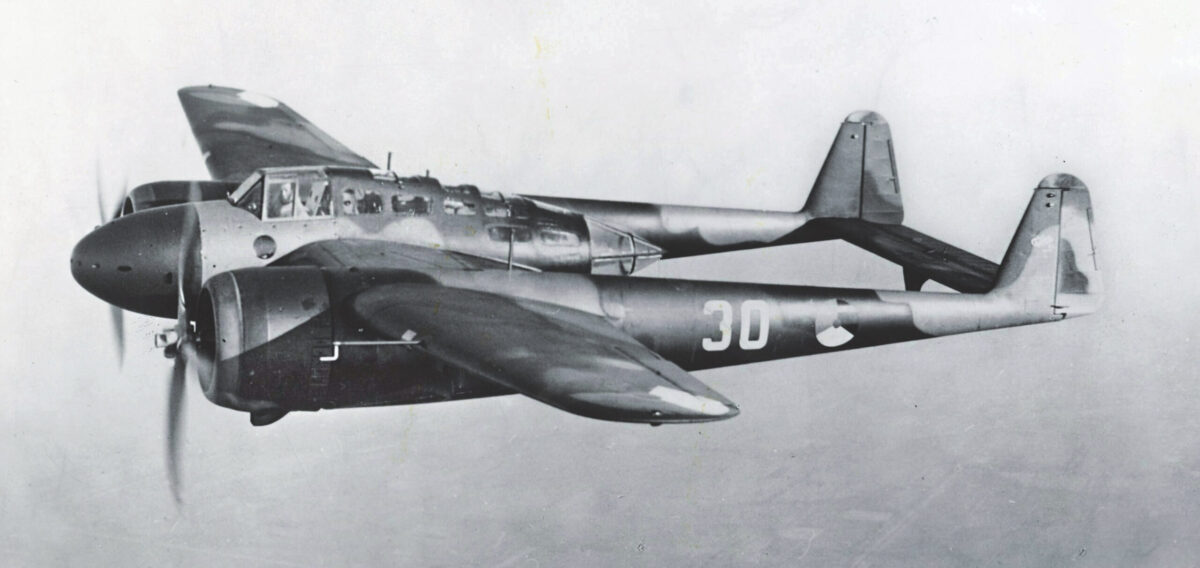The concept of the general-purpose fighter—a long-range, heavily armed airplane capable of achieving air superiority while at the same time shouldering other tasks, such as bombing and reconnaissance—came into vogue with the development of the twin-engine Polish PZL P.38 Wilk (wolf) in 1934. Over the next few years, that design would inspire a variety of twin-engine fighter designs in other countries, such as the French Potez 63 series, the German Messerschmitt Me-110, the British Westland Whirlwind, Japan’s Nakajima J1N and Kawasaki Ki-45, and the American Bell YFM-1 Airacuda and Lockheed P-38 Lightning.
If the versatility of a multi-role fighter seemed attractive to the major powers, it was even more so to small or intermediate powers such as the Netherlands, offering the prospect of wringing more usefulness per airplane from their limited defense budgets. When the prototype of the Dutch-built Fokker G.I twin-engine fighter was first unveiled at the 1936 Paris Salon, however, it caused an international sensation.
Conceived in 1934 by Fokker’s chief designer, Dr. Erich Schatzki, as a twin-boom heavy fighter with a central nacelle that could be modified to fulfill a variety of tasks, the G.I made its first flight on March 16, 1937, and entered service with the Dutch air force in 1938. Powered by two 825-hp Bristol Mercury VIII nine-cylinder radial engines, the G.1, as the air force designated it, had no fewer than eight 7.9-millimeter FN-Browning M36 machine guns in the nose of the nacelle, as well as a ninth gun in a rotating tail cone. In addition, it could carry an internal bomb load of 880 pounds. Fokker also produced 12 somewhat smaller G.1s to be powered by two 750-hp Pratt & Whitney R-1535-SB4-G Twin Wasp Junior 14-cylinder radials and packing a nose armament of two 23-millimeter Madsen cannons and two 7.9-millimeter FN-Brownings for Republican forces in the Spanish Civil War.
Fokker negotiated sales to Finland, Estonia, Sweden, Denmark, Hungary and war-torn Spain, but none of them panned out before World War II broke out, leaving all the G.Is built to guard the Netherlands’ neutrality. The Reaper’s first victim was British: a Whitworth Whitley Mark V of No. 77 Squadron, Royal Air Force, that strayed into Dutch airspace on the night of March 27, 1940, and was brought down by a Fokker G.IA flown by First Lieutenant Piet Noomen, of the 3rd JachtVliegtuig Afdeling (fighter squadron), or JaVA.
A total of 62 Fokker G.1s are believed to have been built to one degree of completion or another, but only 23 were available to the Dutch—11 with the 3rd JaVA at Waalhaven and 12 with the 4th JaVAat Bergen—when the Germans invaded. Considering the circumstances, they gave an outstanding account of themselves, shooting down at least 13 German aircraft in their first chaotic two hours of combat. Heavily armed and easy to fly, though too slow to compete with single-engine fighters, the G.1 lived up to its nickname of Le Faucheur (‘the reaper’), but it only had five days in which to do its reaping before the Germans overran the Netherlands. After that, most surviving G.1s—including 12 Twin Wasp powered versions still under construction for possible export to Finland, which the Germans completed for their own use—became part of a growing trove of war booty serving the Luftwaffe as twin-engine fighter trainers. No Fokker G.Is survive today, but a replica can be seen on display at the Nationaal Militair Museum in Soesterberg.






